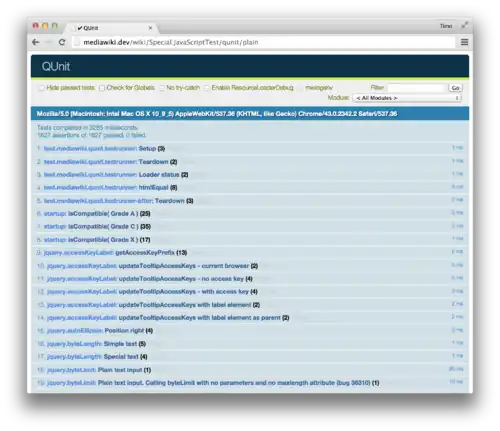
MediaWiki uses QUnit to unit test its JavaScript code base.
Run from a browser
- Set
$wgEnableJavaScriptTesttotrue. ( This is already set if you use MediaWiki-Docker or MediaWiki-Vagrant.) - Visit Special:JavaScriptTest in a browser to run the tests.
Run from the command line
One-time setup
Enter an isolated environment where you have Node.js and npm. Why?
If using MediaWiki-Docker:
- Consider using Fresh
- Run
fresh-node -net -envfrom the MediaWiki core directory. ( Fresh automatically finds the MW address in Docker's.envfile.) - Once inside your isolated shell, run
npm cito install or update any dependencies.
If using MediaWiki-Vagrant:
- Ensure environment variables
MW_SERVERandMW_SCRIPT_PATHare set (consider saving this to.bash_profile):export MW_SERVER=http://localhost:8080 export MW_SCRIPT_PATH=/w
- Run
vagrant sshfrom the MediaWiki-Vagrant directory. - Once inside the Vagrant VM. navigate to the MediaWiki core directory and run
npm ci.
If using a different setup:
- Ensure environment variables
MW_SERVERandMW_SCRIPT_PATHare set (consider saving this to.bash_profile):# Adjust to your own environment export MW_SERVER=http://localhost:8080 export MW_SCRIPT_PATH=/w
- Consider using Fresh, or if you have an isolated environment already, ensure a comparable version of Node.js and npm are installed (the before-last LTS should do).
- Navigate to the MediaWiki core directory and run
npm ci.
Run
This runs the QUnit tests in Headless Chrome:
$ npm run qunit
Running "karma:main" (karma) task
INFO [launcher]: Starting browser ChromeHeadless
mediawiki.util
✔ escapeRegExp
✔ debounce
…
Finished in 5.42 secs
SUMMARY:
✔ 440 tests completed
You can run QUnit tests for specific components with the --qunit-component option.
Pass the name of an extension or skin, or MediaWiki for MediaWiki core tests.
$ node_modules/grunt/bin/grunt qunit --qunit-component=GrowthExperiments
Running "karma:main" (karma) task
INFO [launcher]: Starting browser ChromeHeadless
testrunner
✔ Loader status
✔ assert.htmlEqual
ext.growthExperiments.Utils.js
✔ serializeActionData
✔ isUserInVariant
ext.growthExperiments.Help/HelpPanelProcessDialog.js
✔ getDefaultPanelForSuggestedEditSession for copyedit
✔ updateEditMode for link-recommendation
✔ updateEditMode for copyedit, isEditing
ext.growthExperiments.Homepage.SuggestedEdits/PagerWidget.js
✔ constructor
✔ setMessage with currentPosition < totalCount
✔ setMessage with currentPosition === totalCount
✔ setMessage with currentPosition > totalCount
ext.growthExperiments.NewcomerTaskLogger.js
✔ constructor
✔ should log impressions
✔ should get log metadata
ext.growthExperiments.StructuredTask/addimage/AddImageUtils.js
✔ getRenderData: target width < original width
✔ getRenderData: the image file needs to be re-rasterized
✔ getRenderData: vector image
✔ getRenderData: target width > original width
✔ getRenderData: 3x target width
✔ getRenderData: 2.5x target width
✔ getRenderData: vertical image with landscape viewport
✔ getRenderData: with specified render width
Finished in 0.03 secs
SUMMARY:
✔ 46 tests completed
]
You can use the --qunit-watch argument for QUnit to watch the files associated with a component, and automatically re-run tests when those files change.
How to contribute?
Run tests before committing
Make it a habit to run unit tests before committing and submitting your changes to Gerrit.
Write unit tests
Write unit tests for new functionality, and consider fillling gaps in coverage when changing existing modules in MediaWiki core.
Write a test
It is the convention to name the test suite file after the module it covers.
For example, mediawiki.user.test.js covers the mediawiki.user module.
Inside the test suite should be a call to QUnit.module with the module name.
The unit tests for MediaWiki core are located in the tests/qunit/suites/ directory.
Register a test
MediaWiki core
Test suites are added to the registration of the mediawiki.tests.qunit.suites module in /tests/qunit/QUnitTestResources.php.
Tests are organised into a directory structure that matches the directory structure of the code being tested.
For example:
The unit test for resources/mediawiki.util/mediawiki.util.js can be found at tests/qunit/suites/resources/mediawiki.util/mediawiki.util.test.js.
Example:
'mediawiki.tests.qunit.suites' => array(
'scripts' => array(
'tests/qunit/suites/resources/mediawiki/mediawiki.test.js',
+ 'tests/qunit/suites/resources/mediawiki/mediawiki.example.test.js',
'tests/qunit/suites/resources/mediawiki/mediawiki.user.test.js',
'tests/qunit/suites/resources/mediawiki/mediawiki.util.test.js',
),
'dependencies' => array(
'mediawiki',
+ 'mediawiki.example',
'mediawiki.user',
'mediawiki.util',
Extensions
Extensions register their QUnit tests via the QUnitTestModule attribute in extension.json.
See also
- Manual:Hooks/ResourceLoaderTestModules
- Manual:JavaScript unit testing/QUnit guidelines
- Writing Testable JavaScript (May 2013), Rebecca Murphey, A List Apart